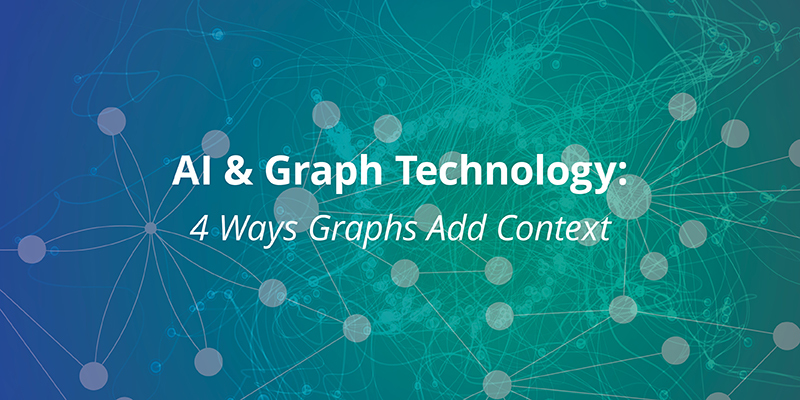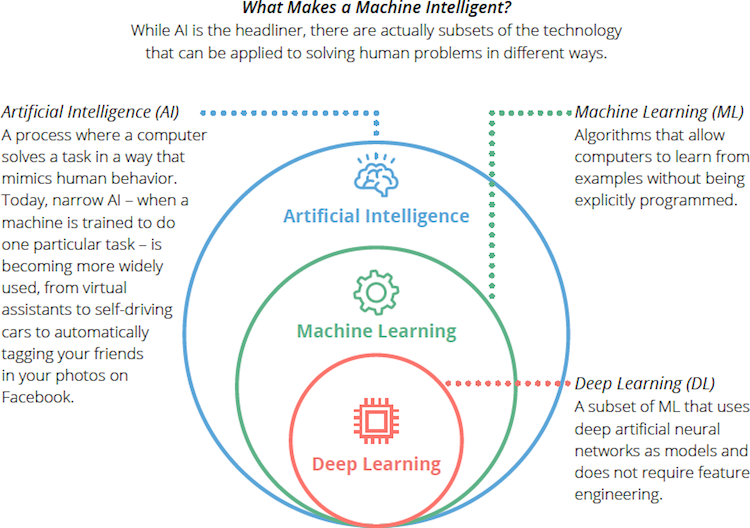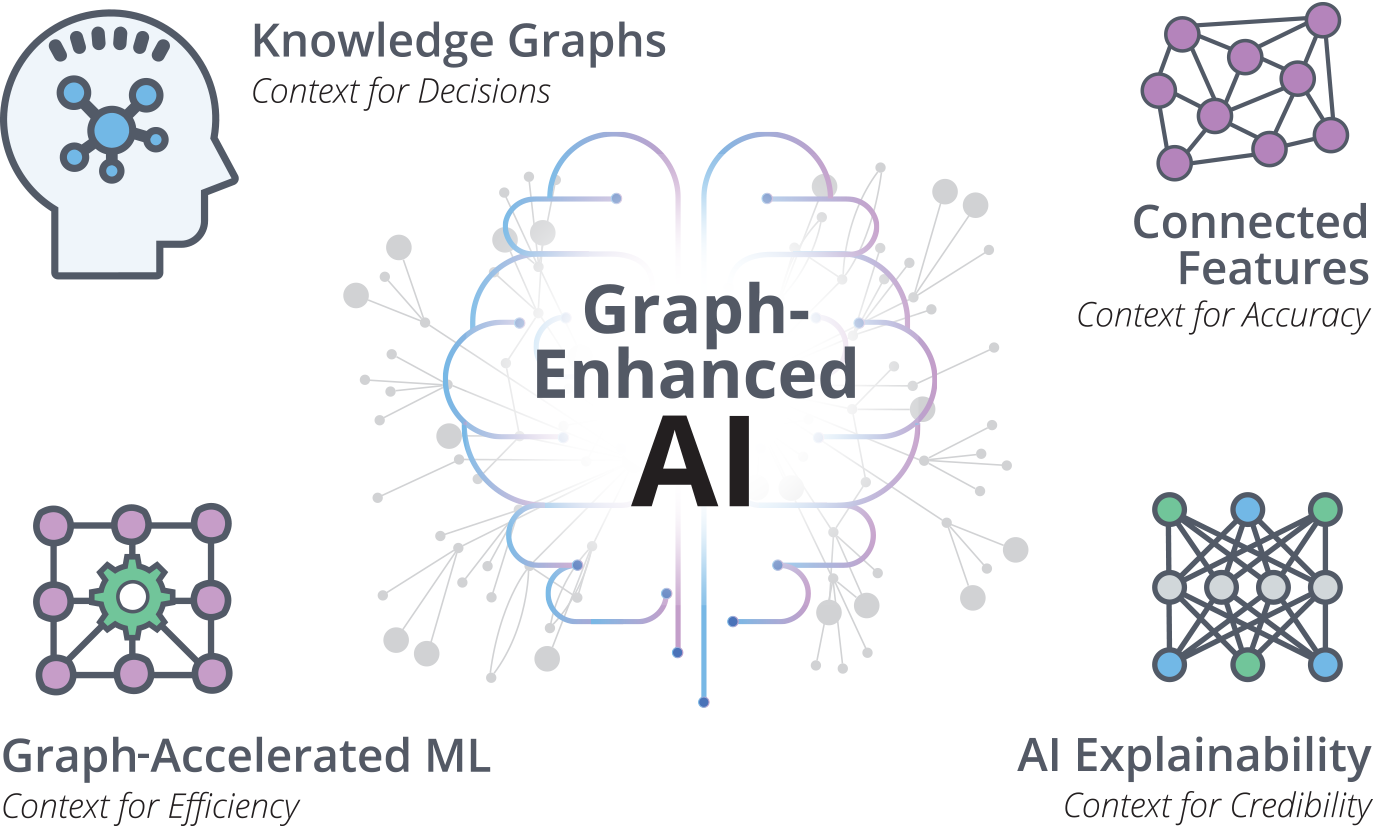AI and Graph Technology: 4 Ways Graphs Add Context

Graph Analytics & AI Program Director
5 min read

The idea of artificial intelligence (AI) has a long history. Loosely defined, AI is a solution or set of tools to solve problems in ways that mimic human intelligence. Usually its most practical goal is to make predictions – either classifying things (such as adding a label) or predicting a value (such as the next number expected in a series).
In a larger sense, AI is categorized as either narrow or general. Narrow AI is focused on performing one task very well, such as image recognition. More general AI includes multiple abilities around planning, language comprehension, object recognition, learning or problem solving.
AI solutions today mostly fall into the narrow AI category, but they are becoming broader in their applicability to novel situations and therefore more powerful over time.
In this blog series, we will consider four ways graphs add context for AI: context for decisions with knowledge graphs, context for efficiency with graph accelerated ML, context for accuracy with connected feature extraction, and context for credibility with AI explainability.
This week, we’ll overview these four ways, giving you a glimpse into how a graph technology platform like Neo4j enhances AI with context.
Why AI Needs Context
One way to make AI applications more widely capable is to provide them with context, surrounding them with related information to use in solving the problem at hand.
Consider the case of self-driving cars. Teaching autonomous vehicles to drive in rainy conditions is difficult because there is so much variability in rainy conditions (think rain on a sunny day, on a cloudy day, with sunlight coming from the left or right, windy rain, wintry mix, etc.).
If the autonomous vehicle’s AI needs to see every possible combination of light and weather conditions, it would be impossible to train it for all possible situations. But if the AI is supplied with connected, contextual information (rain and night, night and temperature), it is possible to combine information from multiple contexts and infer the next action to take (like slowing down or turning on headlights).
Graph technology connects data and defines relationships. By enhancing AI with related context, graph technology offers an effective means to empower the development of sophisticated AI applications.
What Is Artificial Intelligence?
There are three major categories of AI technology that each solve problems in different ways. Artificial intelligence is an umbrella term that includes the subset of machine learning (ML) and deep learning (DL).
AI is a computer process that has learned to accomplish tasks in a way that mimics human decisions. Note that this does not require there to be actual intelligence. It does, however, leave the door open for many ways to perform tasks that are characteristic of human intelligence.
AI is the solution goal, and machine learning is essentially a method for achieving it.
Machine learning uses algorithms to learn by specific examples and progressive improvements, without explicit programming.“Training” an AI involves providing a lot of data to an algorithm to enable it to learn how to process
that information. The “learning” part of machine learning means that the algorithms iterate to optimize an objective function, like error or loss reduction. Machine learning is dynamic, with the ability to modify itself when presented with more data.
Deep learning is a subset of machine learning that uses multiple layers to cascade learning and work with hierarchical abstractions. The “deep” part of deep learning refers to multiple hidden layers of abstraction. These layers enable
feature hierarchies such as adding shape, size and smell to a fruit category.
Since AI aims to make choices the same way people do, it needs to look into the most important class of information people use to make decisions: context. AI needs context in order to mimic human intelligence.
The Importance of Context for AI
Context is crucial to decision making, for humans as well as artificial intelligence. Adults make tens of thousands of decisions every day (some say around 35,000), and most are dependent upon our surrounding circumstances or perspectives.
If we’re making travel arrangements, our decisions vary significantly depending on whether the travel is for work, pleasure or with others. In language, meaning is highly dependent on the situation as well as who uses a phrase and their intonation. For
example, a person who says “Get out!” may be expressing a friendly note of surprise or demanding that someone leave the room.
Humans use contextual learning to figure out what’s important in a situation and how to apply that to new situations. For artificial intelligence to make decisions closer to the way humans do, it needs to incorporate a lot of context. Without peripheral and related information, AI requires more exhaustive training, more prescriptive rules and more specific applications.
4 Ways Graphs Provide Context
There are at least four main areas where graphs provide context for AI, which we’ll detail in the following sections throughout the rest of this blog series
First is knowledge graphs, which provide context for decision support (e.g., for call center staff or support engineers) and help ensure that answers are appropriate to the situation (e.g., autonomous vehicles in rainy driving conditions).
Second, graphs offer greater efficiency of processing, and thus graph accelerated machine learning uses graphs to optimize models and speed up processes.
Third, connected feature extraction analyzes data to identify the most predictive elements within data. Basing a predictive model on strong characteristics found in the data improves accuracy.
Fourth and finally, graphs offer a way to provide transparency into the way AI makes decisions. This area is called AI explainability.
Conclusion
AI and machine learning hold great potential for businesses, governments and individuals. If you’re building an AI solution, graph technology can give it contextual power. In the following blogs in this five-part series, we will continue showing specific areas where graphs provide context for AI.
Next week, we will cover knowledge graphs, which provide context for decision support (e.g., for call center staff or support engineers) and help ensure that answers are appropriate to the situation (e.g., autonomous vehicles in rainy driving conditions).
Read the white paper, Artificial Intelligence & Graph Technology: Enhancing AI with Context & Connections









